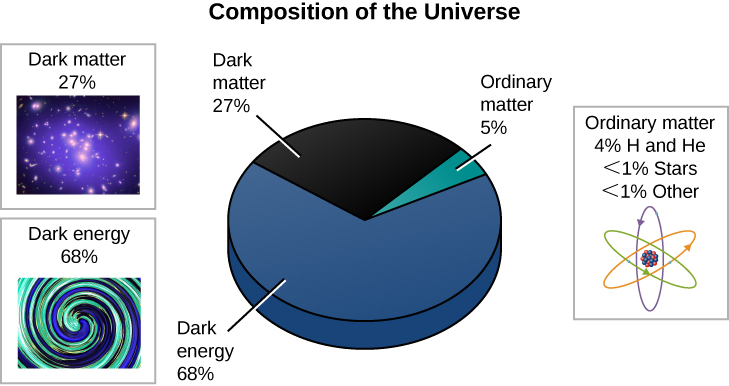| << Chapter < Page | Chapter >> Page > |
By the end of this section, you will be able to:
The model of the universe we described in the previous section is the simplest model that explains the observations. It assumes that general relativity is the correct theory of gravity throughout the universe. With this assumption, the model then accounts for the existence and structure of the CMB; the abundances of the light elements deuterium, helium, and lithium; and the acceleration of the expansion of the universe. All of the observations to date support the validity of the model, which is referred to as the standard (or concordance) model of cosmology.
[link] and [link] summarize the current best estimates of the contents of the universe. Luminous matter in stars and galaxies and neutrinos contributes about 1% of the mass required to reach critical density. Another 4% is mainly in the form of hydrogen and helium in the space between stars and in intergalactic space. Dark matter accounts for about an additional 27% of the critical density. The mass equivalent of dark energy (according to E = mc 2 ) then supplies the remaining 68% of the critical density.

| What Different Kinds of Objects Contribute to the Density of the Universe | |
|---|---|
| Object | Density as a Percent of Critical Density |
| Luminous matter (stars, etc.) | <1 |
| Hydrogen and helium in interstellar and intergalactic space | 4 |
| Dark matter | 27 |
| Equivalent mass density of the dark energy | 68 |
This table should shock you. What we are saying is that 95% of the stuff of the universe is either dark matter or dark energy—neither of which has ever been detected in a laboratory here on Earth. This whole textbook, which has focused on objects that emit electromagnetic radiation, has generally been ignoring 95% of what is out there. Who says there aren’t big mysteries yet to solve in science!
[link] shows how our ideas of the composition of the universe have changed over just the past three decades. The fraction of the universe that we think is made of the same particles as astronomy students has been decreasing steadily.

Notification Switch
Would you like to follow the 'Astronomy' conversation and receive update notifications?